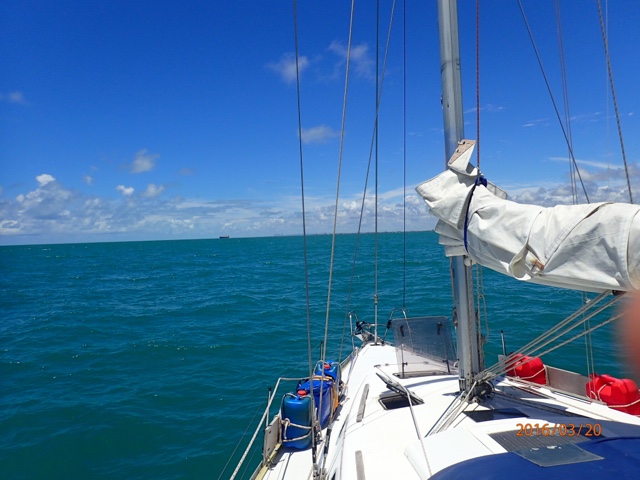Day 13 The wind had picked up and we were close hauled traveling at 4-5 knots with a double reefed main and a full jib which we reduced midday as squalls were imminent. This was an uncomfortable sail while it lasted, we put the engine on for the evening then off again around midnight - jib back out.
Day 14 We were close hauled again, not comfortable but 'Doc' liked it, 5 knots. At 11:15 am the biggest squall ever, toe rail was almost submerged so we altered course to broad reach until it passed, then back on course. No wind. Engine on, off again a couple of hours later - broad reach. We checked the engine oil, gearbox oil and stern gland. The engine was on then off. During the evening it was very squally, the night was black with zero visibility, wind on nose, not fun - raining constantly.
Day 15 It was still raining, very grey and miserable, both weather and crew. They should have been fuel in the tank but it had read empty so we syphoned some more from our jerry cans. The engine was back on again in the afternoon but by the evening there was 30 kts of wind. This was a squally night with plenty of thunder and lightening but we were glad of the wind as we were getting worried about our dwindling diesel supplies. A bird hitched a ride with us overnight, leaving us in the morning.
Passing tanker 'Hector' - we think it said Liverpool on the back - must get some better binoculars - we fancy a telescope/monoscope
Day 16 The morning had been great with the wind steady and giving us an easy 5 kts. We had collected some rainwater overnight in a large bucket and Alison washed & conditioned her hair with it.'Bliss' she said. We were a bit (lot) bored with our menu onboard so decided to make pancakes for lunch.....yummy! At 5pm a squall hit us, no problem......then another, except it wasn't a squall but a weather front. It hit us with such force that it broke our Jib Roller Furler.....we couldn't roll it in! Items had been thrown around our cabin and even a light fitting had shook loose. We had no option but to run with the wind (wind behind us). After a few hours of heading in the wrong direction, we decided to heave to. This was not too comfortable with a full jib and the bow into the building sea, however it gave us time to assess damage and think......... Then the bilge pump started to operate! We pulled up the floor boards to see water lapping into the bilge. I fetched a hand pump to give the electric one some help. Water was coming in but from where? We checked all the sea cocks and thru hulls...all dry. The only conclusion was the water came in when the bow dunks itself into the waves???
Hove to
Action stations all hands to the pumps.
Day 17 Come daylight we managed to inspect the roller furler and Alison managed to do a partial repair whilst sitting in the anchor locker which enable us to roll most of the jib in....phew! Started to sail again and we were back on course and no more water coming. We were still wary of the weather, wondering how long the big winds were going to last. The interior of Artemis was a bit of a mess after the night before so we had a good tidy up. We were a bit tired but we had a good sail during the night.
Day 18 The wind had abated and to make headway against the strong swell and current in this part of the Atlantic (Guiana Current) we needed the jib out which did the trick. Yes you've guessed it....the wind increased dramatically and we couldn't roll the jib in, it was stuck tight. Our only alternative was to take the sail down. Not simple. The bolt rope guide sections had become mis-aligned and the sail was stuck mid way. After an hour of pulling and shaking, and the use of our boarding step on the foredeck we eventually got it down and dragged it down the fore hatch. We were now off course, close hauled under mainsail alone...not happy! The wind died and we motored for 23 hours.
Day 19 The ocean waves and swell have never been big but have a heavy handed power as if the water carries more density than normal.
We were worried about our diesel supplies so we switched the engine off and searched for our storm sail. We had never used this sail before and we threaded it up. We shook the reefs out of the mainsail and started to make slow but steady headway. We put our remaining can of diesel, including all the dregs, filtering into the tank.
Storm jib in action.
We saw the Brazilian coast but didn't want to arrive too soon as it was not recommended to go up the Paraiba river in the dark. We got close in the night and had to tack out to fill in the time. Unfortunately the GPS showed us to be going backwards so about turn again at dawn. When we deemed ourselves in range we started the engine, took the sails in and plied our way up the river, past Cabedelo where cargo ships unloaded and followed Jacare Marinas waypoints to our destination. (Waypoints are on their website but of course any red or green buoys take priority). On the way powerboats and jet skis roared past us and we saw butterflies and small crazy tropical birds (like a Walt Disney cartoon). Radioing ahead got no response (Sunday) so we identified a free space on the outer pontoons in case of draught issues and with the help of neighboring yachties berthed Artemis after 20 days at sea. First job - COLD BEER !



















